Hi Everyone,
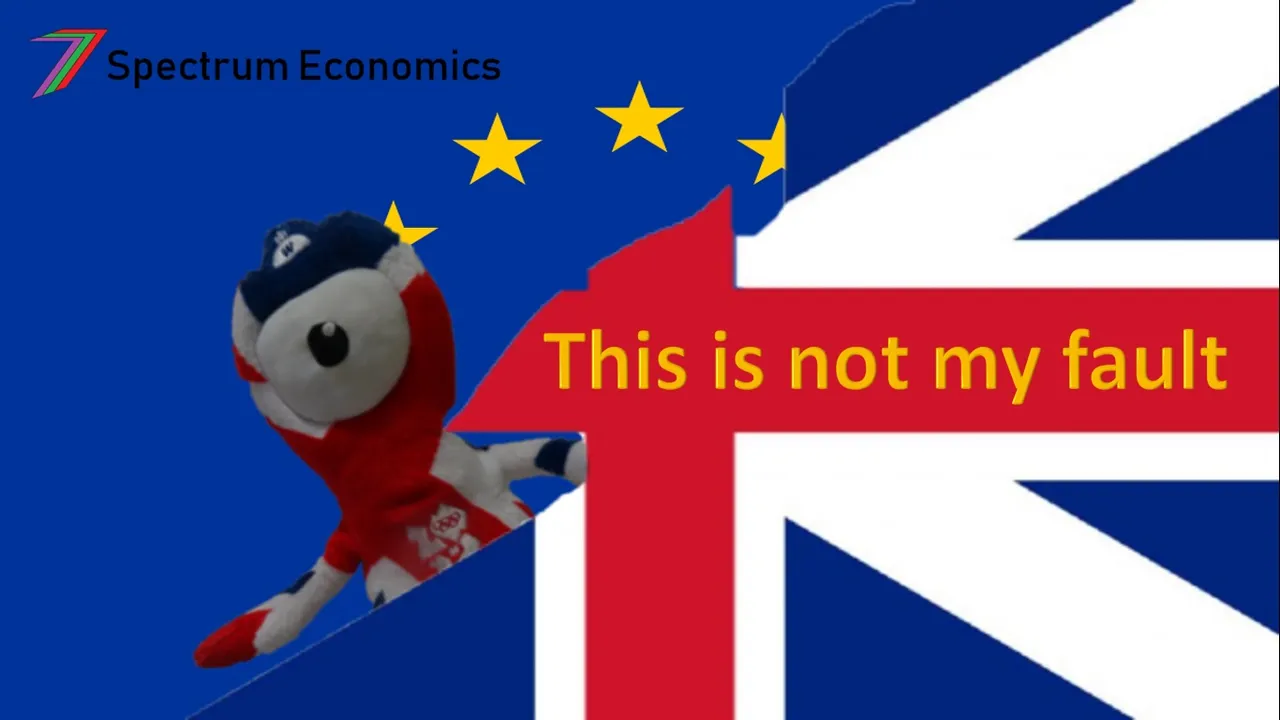
The Brexit cloud of chaos and confusion still hangs in the air. October 31st is the still the date slated for the United Kingdom’s departure from the European Union. Since my previous post, ‘Brexit – Still hanging around’, a lot has and has not happened if that makes any sense. There has been plenty of drama in the British Parliament but not a lot of action in regards to negotiating a new deal.
Theresa May stepped down as Prime Minister on 7th June 2019. Boris Johnson became Prime Minister on 24th July 2019. For the period of the extension from 30th March to 24th July 2019, it would appear close to zero progress was made to reaching a new deal with the European Union. Almost four months of the seven-month extension was consumed over the leadership of the Conservative Party. Since Boris Johnson has become Prime Minister, there has been very little evidence to suggest that any progress has been made to reach a new deal even though he has repeatedly claimed that a deal will be reached with the European Union before 31st October.
Making a deal

A deal should be to benefit of both parties. Not reaching a deal should therefore hurt both parties. There are a number of factors that determines which party gets the better deal. The factors that I would like to highlight, which I believe are most relevant to Brexit, are as follows.
- The cost of no deal to each party
- Costs of negotiating the deal
- The extent of benefits of each particular deal
- The level of mutual benefits from each particular deal
- Time available to make the deal
- Commitment to walking away if the other party does not agree
The negotiators can control some of these factors such as commitment to walking away. Other factors can be influenced through negotiation such as the extent of benefits, mutual benefits and possibly the amount of time available to make the deal. There are also factors such as the cost of ‘no deal’, which can only be partially mitigated through preparation and the costs of negotiating, which can be managed but not eliminated.
It is difficult to ascertain the costs of ‘no deal’ to each negotiating party. For the United Kingdom, the short-run costs could be quite high as businesses and the public will need to adjust to new circumstances but the long-run costs could be minimal if good deals are struck with other countries. The newly released document ‘Operation Yellowhammer’, outlines some of the difficulties the United Kingdom will need to contend with in the event of a ‘no deal’.
For the European Union, the costs of ‘no deal’ is different for each country. Countries that trade more heavily with the United Kingdom will be hurt more. There are likely to be both short-run and long-run problems as the disadvantaged countries in the European Union will need to rely on the European Union to help resolve these problems.
The costs of negotiating the deal falls on both the United Kingdom and the European Union as negotiations are taking time and resources away from other important matters. The costs of negotiating have arguably fallen more heavily on the United Kingdom because of the unnecessary parliamentary theatrics. I discuss some of these later in the post.
Over the course of the three years since the referendum, there has been a range of deals discussed. They vary from soft deals such as the Norway type deals to the harder deals such as the Canada type deals. Soft deals are likely to be more beneficial to the European Union as they can maintain close trade relationships with the United Kingdom through either the single market or customs union. A soft deal has both advantages and disadvantages for the United Kingdom. There is the advantage of maintaining a close relationship with the European Union but the disadvantage of still being tied to some of the European Union laws as well as less options to make deals with countries outside the European Union. I make a more detail comparison in my post ‘What’s going on with Brexit?’.
The first deadline for the deal was 30th March 2019. It has now been extended to 31st October 2019. The timeframe is clearly not definitive but relies on both the United Kingdom and the European Union agreeing to an extension. The cost of an extension is arguably higher for the United Kingdom than the European Union as the delays are causing both uncertainty and loss of confidence in the Government.
Figure 1: Benefits of the deal
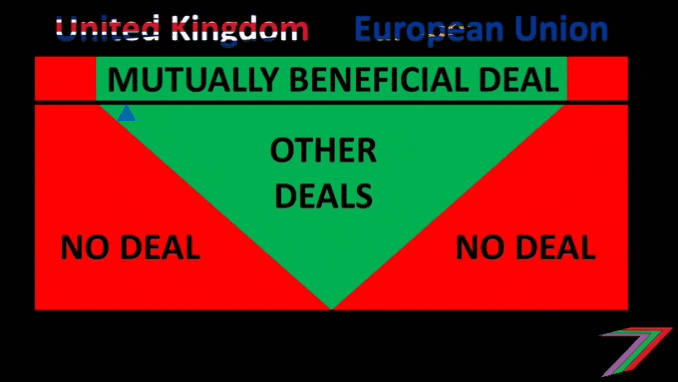
Note 1: The moving blue arrow indicates the range of deals and benefits for the United Kingdom and European Union with a well negotiated deal by both parties.
Note 2: The green area represents deals, which are favourable to both the European Union and the United Kingdom. The red area represents deals, which are unfavourable to either the United Kingdom or the European Union.
There should be opportunities on both sides to make a reasonable deal. Figure 1 shows a simple example of where the deal should sit. Ideally, the types of deals discussed should offer the maximum benefits. The party that performs better at the negotiating table, dependent on the factors described above, should obtain the larger share of these benefits.
The only factor I have not discussed is the commitment to walk away with ‘no deal’. This is possibly the most important factor to obtaining a favourable deal.
No deal problem
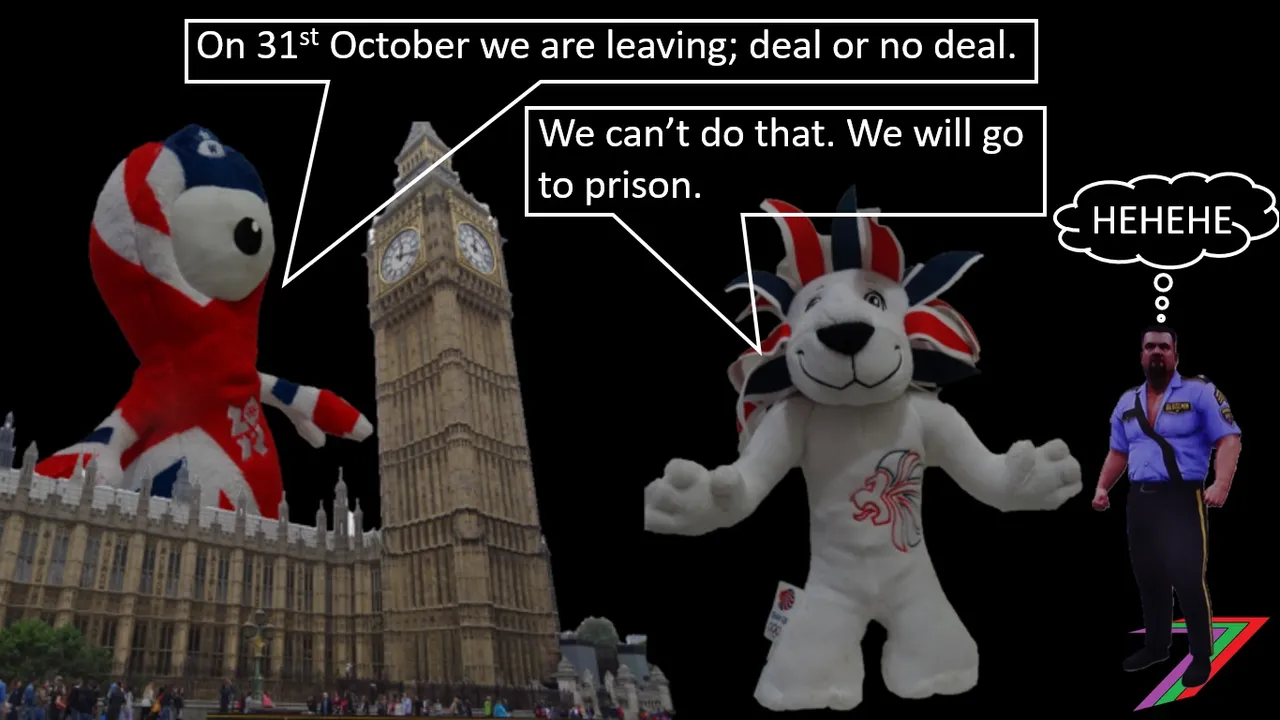
The British Parliament has passed a law making ‘no deal’ illegal. If we assume ‘no deal’ is now impossible, the United Kingdom are at the mercy of the European Union. They either accept the European Union’s terms or ask for an extension in the hope the European Union will accept a compromise.
The willingness to walk away from a deal is critical to obtain a good deal. If both parties are willing to walk away without a deal, the scope to negotiate a deal is far broader. See Figure 2 below.
Figure 2: Deal opportunities with willingness to walk away from the deal
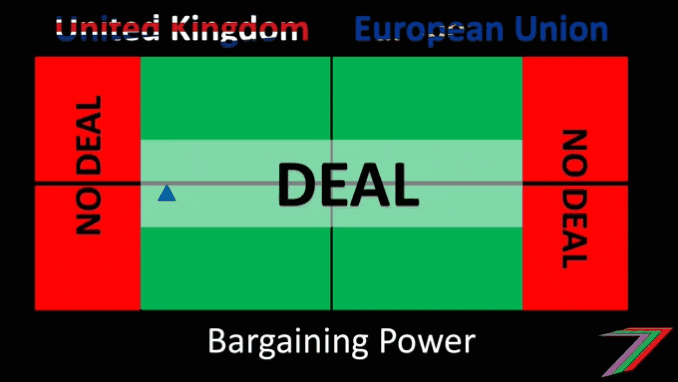
Without the option to walk away from the negotiating table, the scope of deals available for negotiation will only be deals that strongly favour the European Union. See Figure 3 below.
Figure 3: European Union controlling the deal
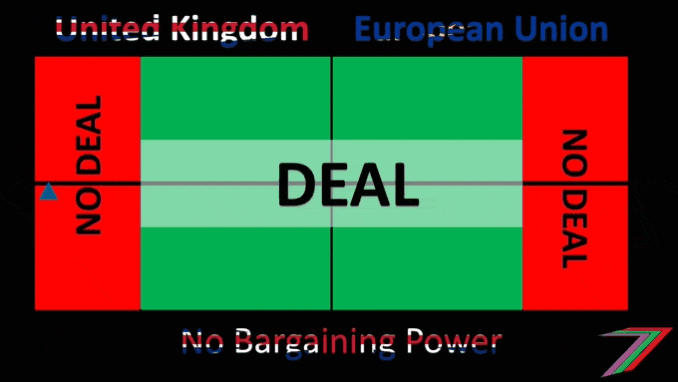
Note: The arrow now moves into the red area indicating a deal worse than ‘no deal’ is possible if a ‘no deal’ option is not possible.
Another way of looking at the negotiations is from a deal by deal basis. Imagine there are four available deals. Some of the deals favour the United Kingdom some of them favour the European Union. There is also ‘no deal’, which is bad for both parties. Any deal that results in an outcome worse than a ‘no deal’ for either party should be dismissed. See Table 1 for a hypothetical example of the benefits of various deals.
Table 1: Picking a deal
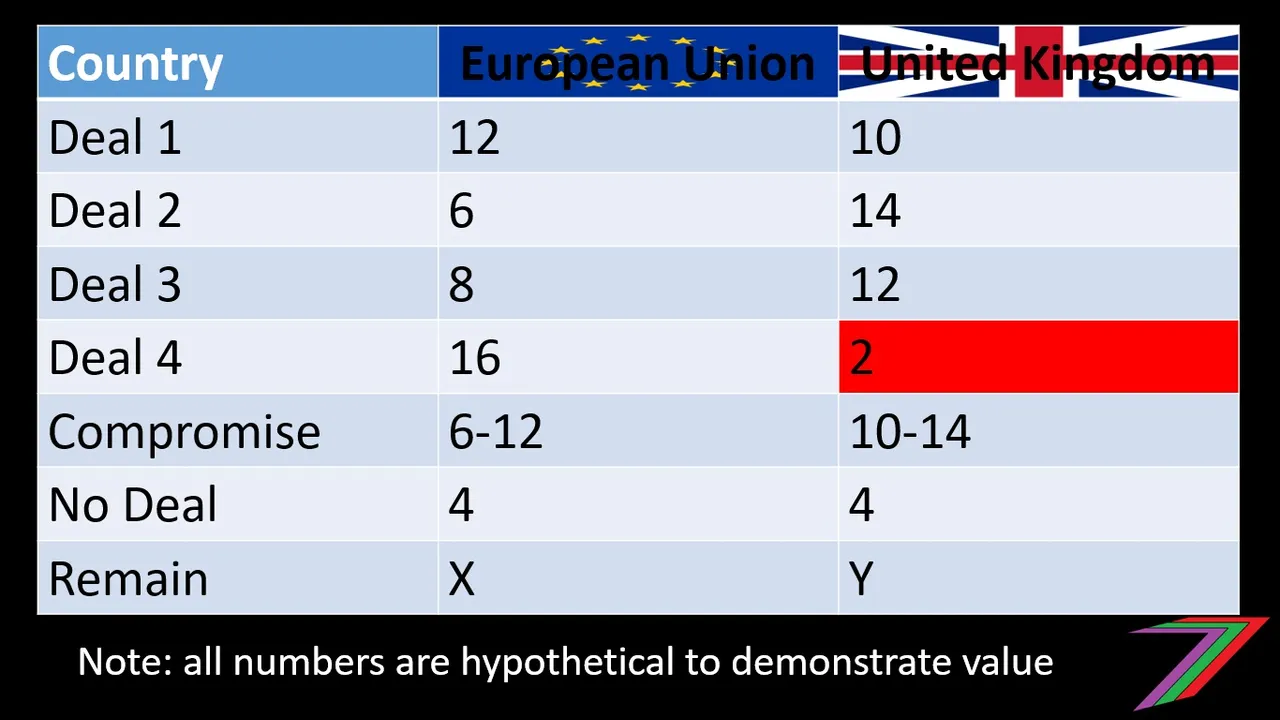
In the example, deals 1, 2, 3 or a compromise are possible outcomes. The deal reached will be better than a ‘no deal’.
If the United Kingdom cannot walk away from the negotiating table without a deal, the deal most favourable to the European Union will be selected. If this results in perpetual delay, the European Union might soften the deal so that the United Kingdom get at least as good as a ‘no deal’. See Table 2 for the example. However, there is no guarantee they will do this, as delays hurt the United Kingdom more than the European Union as discussed earlier in this post.
Table 2: European Union controls the negotiation
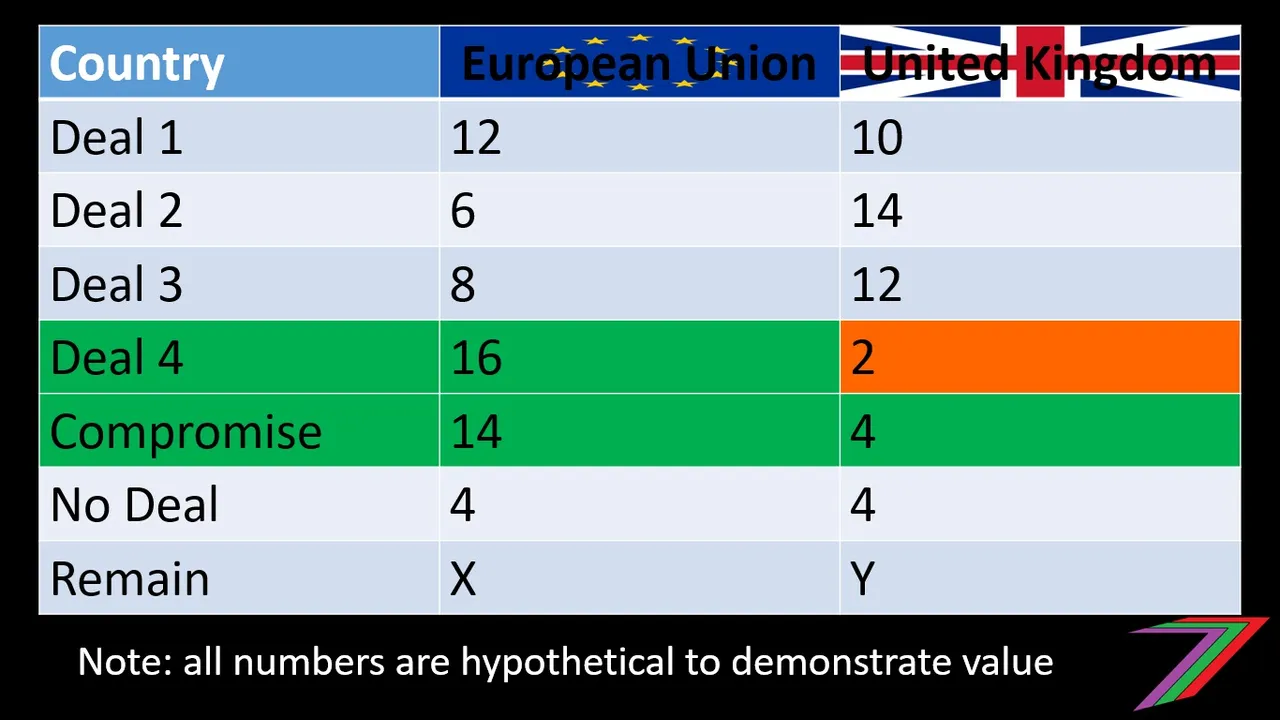
I have also included ‘remain in the European Union’ in the tables. This is relevant if either party believes that the United Kingdom remaining in the European Union is a possible outcome. Many leaders in the United Kingdom and the European Union have expressed that remaining is the favoured option. I would strongly argue that the United Kingdom remaining in the European Union is the best outcome for the European Union. Therefore, the European Union could choose to make a deal as unfavourable as possible to pressure the United Kingdom into holding a second referendum. I strongly believe this to be the case, I explain this idea further in my post, ‘What’s going on with Brexit?’.
Proroguing of Parliament and a dash of drama
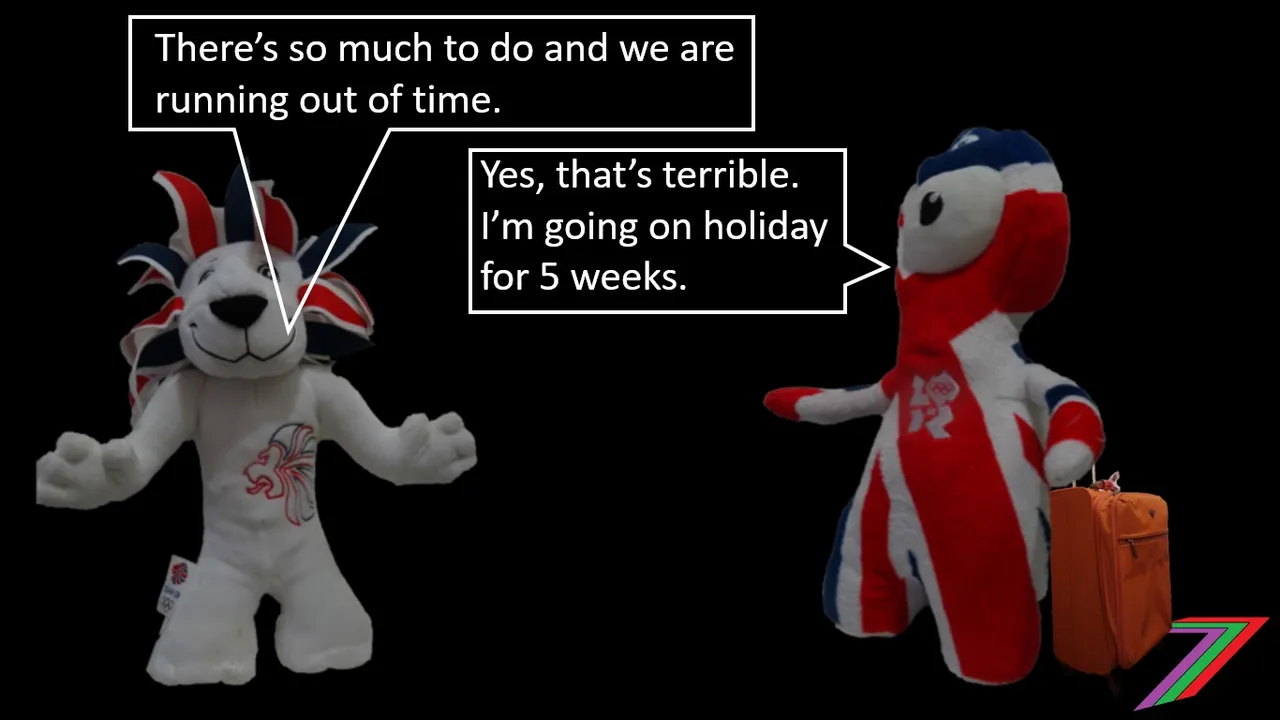
Considering so much of the extension has been consumed not progressing a Brexit deal. The Prime Minister Boris Johnson decided to ask the Queen to prorogue Parliament for an extended period. This greatly reduces the amount of time available to debate any new Brexit deal. The imminent proroguing of parliament most likely began the chain of events that led to the banning of ‘no deal’ Brexit and the Conservative Party losing their majority in Government. A snap General Election was tabled but defeated. This has possibly left the Conservative Government completely powerless to make any decisions.
My prediction

I believe Brexit is in the best interest of the United Kingdom. However, I do not believe it will happen. Despite Boris Johnson claiming that the United Kingdom will leave the European Union on the 31st October, I believe he or someone else from the Government will request an extension. The European Union will accept this extension.
I am predicting shortly after the extension request, there will be a vote of no confidence in the current Government. This will lead to a General Election before the end of 2019. Failure to bring the United Kingdom out of the European Union will result in a plunge in the popularity of the Conservative Party with many voters switching to the Brexit Party.
I believe the result of the election will lead to a hung parliament. The Labour Party, Liberal Democrats, and Green Party will form a coalition Government. This new Government will propose an alternative Brexit deal; most likely a very soft deal, which will involve remaining in the customs union or single market. They will then call for a Second Referendum giving the public a choice between this new deal and remaining in the European Union. I believe the outcome of the referendum will be in favour of remain in the European Union.
I hope this prediction is completely wrong but I believe there are many people in powerful positions who want the European Union to remain united. The successful departure of the United Kingdom could become the beginning of many countries departing the European Union.
Conclusion
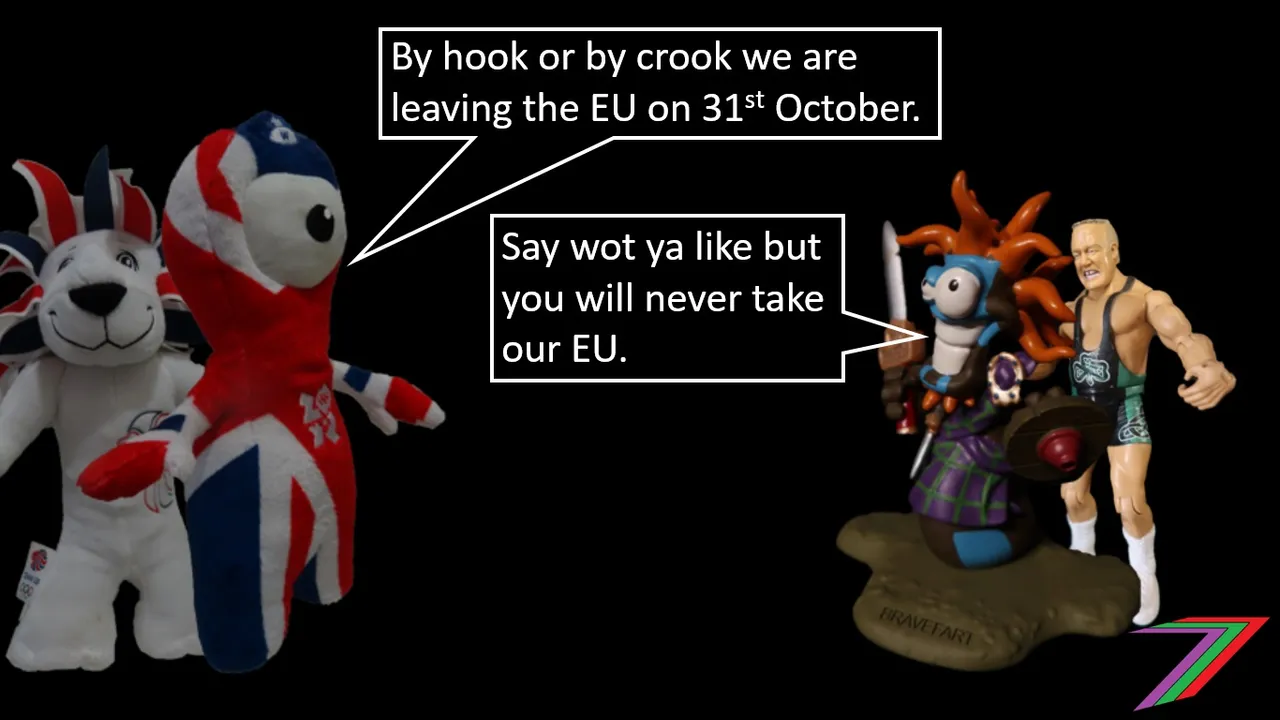
The handling of Brexit is about as bad as possible. I believe this is intentional as an attempt to stop Brexit. I also believe this is intentional to split the country into ‘Leavers’ and ‘Remainers’. The country is truly divided on this matter. This division is for the worse. Both camps are blindly supporting any actions that improves their own camps position regardless of whether these actions are ethical or not. Leavers are supporting Boris Johnson’s decision to override democratic discussions; possibly setting a dangerous precedent. They also support his deceptive tactics and promises to garner more support and votes. Remainers are supporting attempts to overrule the results of the referendum and sabotage any possible negotiations with the European Union by making ‘no deal’ illegal.
Regardless of where we stand in regards to Brexit, we should first stand for an honest and ethical approach. I believe fault lies largely with a system that does not function to serve the best interests of the people. I have made several posts criticising Western governing systems. I will be making posts proposing changes to get us onto a better path. Many of these will be ideas in their infancy but we need to start somewhere.
More posts

If you want to read any of my other posts, you can click on the links below. These links will lead you to posts containing my collection of works. These posts will be updated frequently.
New Economics Udemy Course

I have launched my first Udemy course ‘Economics is for Everyone’. The course focuses on how economics affects everyday people, the decisions they make and how they interact with the world around them. The course contains 24 video lectures (about 4 hours of viewing), 64 multiple-choice questions (3 at the end of most lectures), 32 downloadable resources (presentation slides, additional notes and links to relevant Steem posts), and 2 scenario questions. The course is currently free-of-charge. Click the link above to access the course.




Steem - The Future of DApps




